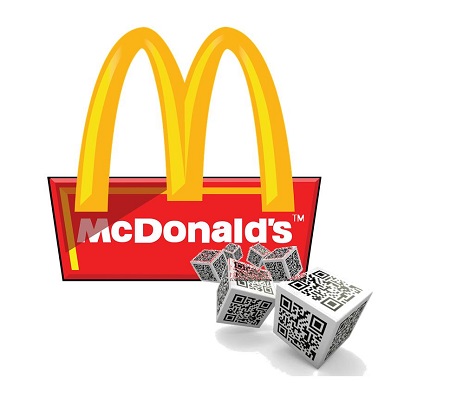A pilot program is now underway using QuickPay for WeChat customers in the country.
McDonald’s is now running a pilot project using QR code payments with a cashback offer. Customers using WeChat can get 50% cash back when they use the QuickPay service. This is exclusive to select restaurants in South Africa.
The goal is to encourage people who are already using the social messaging app to pay with their smartphones.
Participating restaurants are located in Cape Town and Johannesburg. Customers using the WeChat mobile app are being offered a special 50% cashback offer. This is mean to encourage them to use the QuickPay QR code payments at McDonald’s in a participating location.
 This incentive is meant to help to encourage customers to try the mobile payments for the first time. By showing them how easy it is to pay for an order simply by presenting the QR codes at the point of sale so they can be scanned, McDonald’s hopes that consumers will be taken with the service and will continue to use it.
This incentive is meant to help to encourage customers to try the mobile payments for the first time. By showing them how easy it is to pay for an order simply by presenting the QR codes at the point of sale so they can be scanned, McDonald’s hopes that consumers will be taken with the service and will continue to use it.
The QR code payment cashback offer is available to the first 20,000 customers to use the service.
Those customers will receive 50% cash back when they pay for their meals with their smartphones. According to the McDonald’s South Africa chief marketing officer, Daniel Padiachy, “We are continuously searching for innovative ways to enhance our customers’ experience.” He added that “We believe that WeChat’s Quick Pay will further assist us in upholding these principles.”
The WeChat app first launched in the country in November 2015. The app is owned by Tencent, the ecommerce giant from China. Payments through the service have been made possible in South Africa through a partnership with Standard Bank.
WeChat makes it possible for users to make P2P transfers as well as to scan QR codes to make payments in-store at any of 30,000 merchants across the country that support the SnapScan platform. The mobile app can also be used to purchase wireless services such as airtime and data, as well as to pay certain utility bills.
While Quick Pay is functioning within the SnapScan WeChat feature, that QR code payments option is currently available exclusively at McDonald’s.
As the fast food chain scrambles for a more healthful image, its wearable tech effort flops.
For a very short time, kids were finding McDonald’s fitness tracker devices in their Happy Meals. This wearable technology gadget was taking the place of the traditional toy the company ads to its kids’ meals.
Shortly after rolling out the Step It wearable technology, kids started complaining of skin irritations.
The McDonald’s fitness tracker made headlines and drummed up a lot of attention for the Happy Meals. However, shortly after its August 9 roll out in the United States and Canada, it was removed. The removal of the wearables was voluntary by the fast food chain. It was in response to several complaints of wrist irritation from wearing the Step It activity bands.
 A spokesperson from the company released a statement. It said “We have taken this swift and voluntary step after receiving limited reports of potential skin irritations that may be associated from wearing the band.”
A spokesperson from the company released a statement. It said “We have taken this swift and voluntary step after receiving limited reports of potential skin irritations that may be associated from wearing the band.”
The McDonald’s fitness tracker is under investigation to determine the source of the skin issue.
The spokesperson underscored that the safety of their customers is of their highest priority. They are conducting a thorough investigation into the problem with the wearable technology band. In the meanwhile, an alternative Happy Meal toy is being distributed to children.
The Step It activity tracker was essentially a pedometer that was worn on a child’s wrist. It was a very basic device meant to promote activity. It provided blinking lights to encourage kids to keep up the good work when they were moving around.
The wearable tech device was designed with four buttons. The first was a power button. The other three let the child identify his or her activity. Activities included: walking, jumping rope and general sports. This allowed the device to more accurately track the type of motion it was sensing.
The McDonald’s fitness tracker isn’t the first wearable technology to have been taken down from skin irritations. The current ruler of the activity band market, Fitbit, once suffered similar struggles. Its own first wearable had to be recalled in 2014 and in 2015. The Fitbit Surge has also received some complaints regarding skin irritations.
 This incentive is meant to help to encourage customers to try the mobile payments for the first time. By showing them how easy it is to pay for an order simply by presenting the QR codes at the point of sale so they can be scanned, McDonald’s hopes that consumers will be taken with the service and will continue to use it.
This incentive is meant to help to encourage customers to try the mobile payments for the first time. By showing them how easy it is to pay for an order simply by presenting the QR codes at the point of sale so they can be scanned, McDonald’s hopes that consumers will be taken with the service and will continue to use it.
